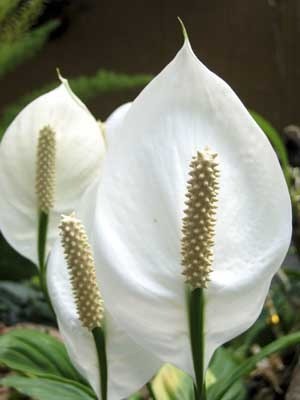
Over the years, different types of houseplants have come in and out of fashion. In the mid-70s it was all about ferns and foliage. In the mid-80s it was orchids, and in the 90s, short-lived flowering houseplants seemed to be the rage. Trends always have a way of coming back around. Today's consumers are looking for ways to live a healthier lifestyle, and that includes creating quality, indoor air and reducing stress. Because of calming effects and purifying properties of certain houseplants, once again, it's all about the green.
When you stop to think about it, it's easy to see the significant role plants play to our psychological and spiritual well-being. Plants are highly symbolic. On a conscious level, they're cheerful, inviting, and aesthetically pleasing to look at. They bring warmth and beauty to our interior spaces. Human beings cannot survive without plants. On the subconscious level, they represent our connection to life, health, and hope for the future. That's probably why you seldom see a plant-free wedding, funeral, holiday, or visit a hospital, dentist or other interior landscape without seeing plants.
Studies have shown that plants have a positive, measurable effect on the humans that interact with them. Just the mere sight of them decreases stress, increases productivity and puts people at ease. This is also why plants are often used in advertising and found in commercial settings like office buildings, hotels, and restaurants.
In addition to the psychological benefits offered by plants, they also offer some very important physical benefits. Plants increase air humidity and extract carbon dioxide from the air while replenishing oxygen. Certain types of plants, like aloe for example, also have known healing properties. But did you know that they also act as air purifiers. Studies conducted in the mid-80s by researchers at NASA in conjunction with the Association of Landscape Contractors of America, found that certain houseplants are effective at reducing indoor air pollution. Researchers studied 17 different types of houseplants and two types of flowering plants (chrysanthemums and gerbera daisies).
Plants were placed inside sealed chambers, which were then injected with formaldehyde, benzene, and trichlorethylene-the types of harmful chemicals found in the carpet, furniture, cleaning products, paints, and adhesives of a typical household or commercial building. According to the study, the plants filtered out 87% of the pollutants within just hours after the chemicals were injected into the chambers. Since that time, various laboratories have continued to conduct experiments on over 42 species of plants.
Plants can't completely purify your indoor air by themselves. For example, plants are not good at filtering indoor pollutants caused by smoking. To maximize the air filtering properties of your houseplants, you need to minimize your use of chemical pollutants. Switch to earth-friendly paints, cleaners and adhesives, and replace worn out carpets and furniture with products made from organic, natural fibers. To utilize the air purifying properties of plants, use 1-2 medium to large plants (14"-16" containers) for every 100 square feet of interior space.
All plants will help contribute to healthier indoor air, but certain species are better at filtering out harmful pollutants than others:

About The Author: Ellen Brown is our Green Living and Gardening Expert. She is an environmental writer and photographer and the owner of Sustainable Media, an environmental media company that specializes in helping businesses and organizations promote eco-friendly products and services.
Add your voice! Click below to comment. ThriftyFun is powered by your wisdom!